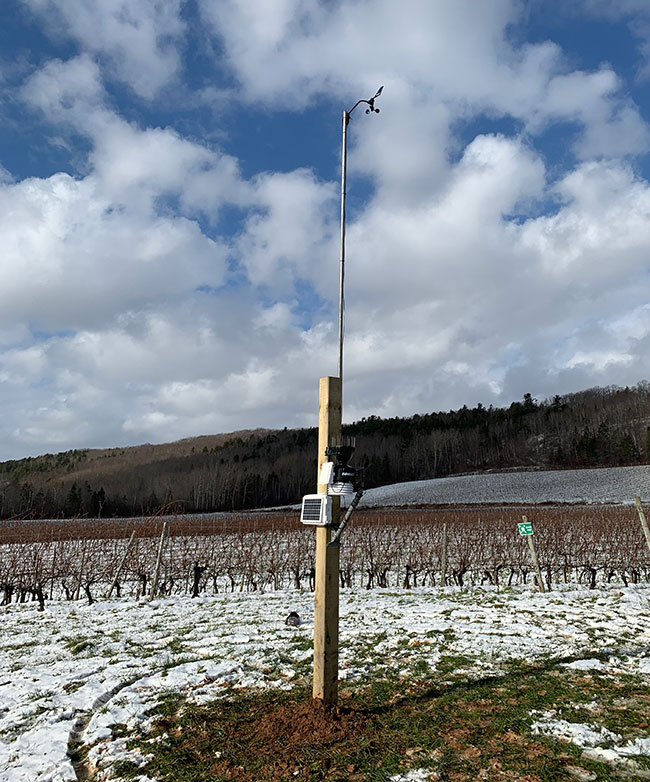
Features
Environment
Harness the power of weather data
Predicting the weather, and whether growers can use that information for pest and disease management. Perennia lays the foundation for weather station decision support tools.
December 5, 2023 By Colin Farrell, Perennia agri-technology specialist
 An on-farm weather station connected to Perennia’s Farm Data Tools platform.
Photo courtesy of Thomas Harrington.
An on-farm weather station connected to Perennia’s Farm Data Tools platform.
Photo courtesy of Thomas Harrington. Depending on weather conditions, pest and disease development may vary from year to year. Growers typically have a good sense of when conditions are right for something to go wrong, but wouldn’t it be great if that next incoming threat to your crop would text you to let you know it’s heading your way? Perennia has taken the first steps to provide growers in Nova Scotia with weather-based decision support tools. These tools use real-time data from on-farm weather stations to help monitor the risk for incoming pests and diseases.
Over the past two years, Perennia has assisted Nova Scotia producers and industry organizations in installing and utilizing on-farm weather stations, purchased with the assistance of the Nova Scotia Department of Agriculture Weather Station Assistance Program. This collaboration resulted in the creation of a network of 100 weather stations situated in Nova Scotia’s farming regions, each recording and transmitting data every 15 minutes.
Perennia is now harnessing the power of this network with the launch of its new Farm Data Tools website (farmdatatools.ca), a web-based platform for weather station decision support tools. The platform offers open access to an interactive weather station map, where users can access current conditions and download historical weather data from all 100 on-farm weather stations. More than this, the platform is the foundation for weather-dependent modelling tools that utilize real-time weather data from a chosen weather station.
So far, Perennia has launched two Farm Data Tools: PomeBlight, a weather-based model with a calculation based on the Maryblyt model developed at the University of Maryland, which provides predictive alerts of fire blight infection risk in apple and pears; and a Growing Degree Day Calculator, which calculates the accumulation of heat within the growing season and is a useful indicator to identify the growth stage of crops and to assess the development of pests and diseases.
This is just the beginning for the Farm Data Tools platform. With this foundation in place, there is a lot of potential to add more crop-specific models and tools relevant to Nova Scotia, which can benefit more growers across commodities.
Luckily for Perennia, this is not a new concept, and there are many great examples of agriculture weather hubs and crop risk decision support tools and calculators across Canada.
Some free, open-access examples that we’ve noticed do a particularly good job of setting the bar high are:
- ONvegetables Weather Dashboard: A regional weather dashboard for the Ontario vegetable industry that features custom date ranges for monthly precipitation, growing degree days and pest threshold calculators;
- ONfruit Strawberry Disease Decision Support System: A risk-modelling tool for Ontario strawberry growers that identifies anthracnose fruit rot and botrytis fruit rot risk based on leaf wetness and temperature data;
- Farmwest Weather-Based Calculator: A weather data hub for the entire British Columbia agriculture industry to access weather data and several decision aid calculators;
- British Columbia Decision Aid System: A web-based platform for the British Columbia tree fruit industry that runs pest, disease, disorder and horticultural models to estimate the current status of the issue and links that to appropriate management and pesticide recommendations; and
- Computer Centre for Agricultural Pest Forecasting (CIPRA): A user-friendly software tool that can predict the development of more than 130 pests and diseases, crops (phenology) and some postharvest disorders based on hourly weather data across Canada.
There is a growing consensus that longer, warmer summers and milder winters will result in greater overwinter survival of pests and diseases, as well as a northward expansion of pests and diseases not currently found in Canada. A reactive approach to this increasing risk of pests and disease is not likely to provide long-term stability for growers. This is why weather-based decision support tools that consider the unique weather needs of each region, like Perennia’s Farm Data Tools, are becoming an increasingly important resource – they provide local, real-time forecasting tools to make well-informed decisions while there is still time to act.
On a positive note, along with new challenges come new opportunities, and growers who are aware and become early adopters of new approaches and technology will be well-positioned to take advantage of these opportunities.
Print this page